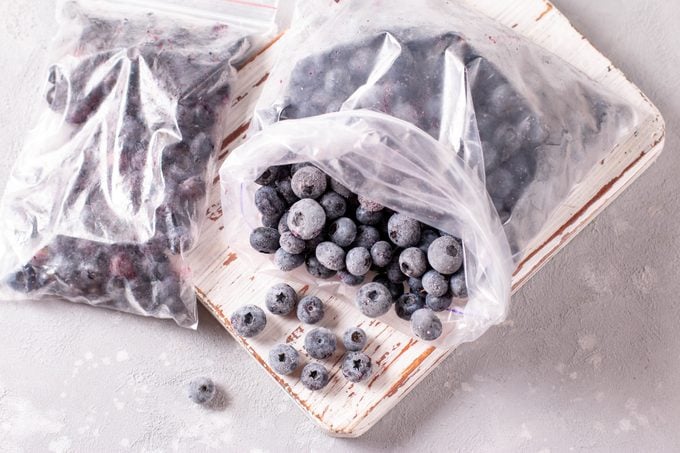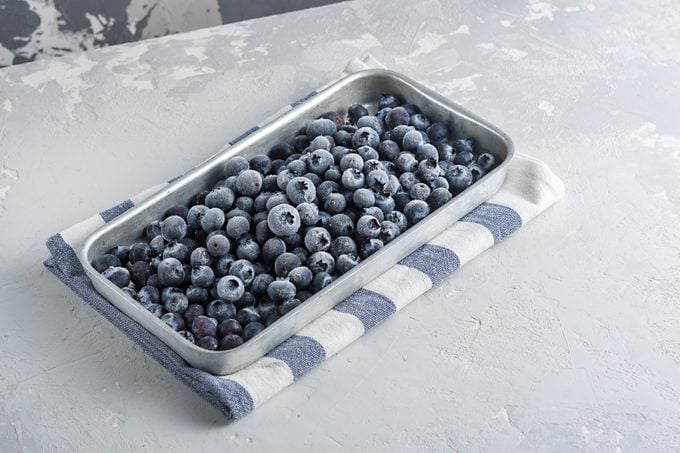How to Freeze Blueberries
Updated: Mar. 28, 2024
Learn how to freeze blueberries for fresh-from-the-garden (or grocery store) goodness all year long.

When my kids were small, we spent hours at the local U-pick berry farm filling basket after basket with ripe fruit. By the time we got home, we had more berries than a family of four could eat. Fortunately, there’s an easy way to preserve that summertime sweetness. Whether you got carried away at the U-pick farm or scored a great deal at the grocery store, you’ll want to know how to freeze blueberries to get the most bang (and vitamins) for your buck.
Before getting started, you’ll want to learn how to pick the best blueberries. This will ensure they’ll taste good whether you’re making recipes with frozen blueberries or thawing them to eat on their own. You’ll also want to freeze the berries at peak freshness. This will lock in all the healthy attributes of the berries like vitamin C and dietary fiber.
Should you wash blueberries before freezing them?
It’s always a good idea to wash blueberries if you’ll be eating them right away. But for freezing, hold off on the washing step until after you’ve thawed them. That waxy white film on fresh blueberries known as “bloom” keeps pests and bacteria at bay, and also locks in their juiciness.
How to Freeze Blueberries: 3 Steps

Step 1: Remove the bad ones
Spread your berries on the counter and give them a good once-over. Remove any berries that appear soft or have wrinkled skin. Be on the look-out for stems and remove those too. You want only the best, most flavorful berries for freezing.
Step 2: Spread on a baking sheet
Line a baking sheet with parchment paper and spread your unwashed berries in a single layer, leaving space between them so they don’t freeze in clumps. If you have a lot of blueberries (or if you’re also freezing strawberries with the blueberries), use several parchment-lined baking sheets.
Step 3: Freeze
Freeze the blueberries for at least two hours. Once frozen, label freezer bags with the date and add your berries. Place the full, labeled bags in the freezer.
How long do blueberries last in the freezer?

While they may only be good for a few days on the counter, freezing berries adds some serious longevity without sacrificing flavor or nutritional value. Blueberries are at their best within six months of freezing, but they’ll still be delicious up to 10 months.
How to Thaw Blueberries
Whether you’ll be using them frozen or thawed, give the berries a quick rinse in a colander as soon as you remove them from the freezer.
For immediate use in your favorite fruit smoothie recipe, simply toss the frozen blueberries in a blender and blend away! (Frozen bananas are another tasty smoothie ingredient.) Frozen blueberries also work really well in muffins, as they don’t turn the batter blue like thawed berries do.
For things like pancakes and pies, thaw the blueberries on the counter in a bowl to catch the juice. Once they reach room temperature (about an hour), they’ll be soft and ready to use.
Tips for Freezing Blueberries
- Pick the best blueberries for freezing. Wrinkled skin or mushiness is a sign that they’re past their prime.
- Don’t rinse before freezing. That waxy coating helps blueberries stay hydrated and flavorful.
- Don’t crowd. If you have a lot of blueberries, freeze them on multiple baking sheets to prevent clumping. It’s easier to get your recipe measurements right when blueberries aren’t encased in a block of ice.
- Use airtight storage containers or freezer bags that prevent freezer burn.
- Label containers so you know when the berries are still at their best.
